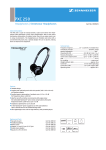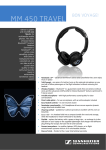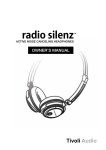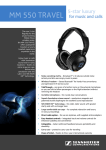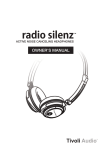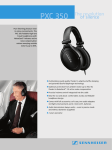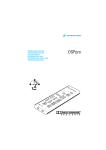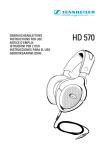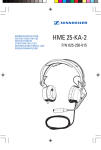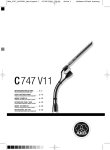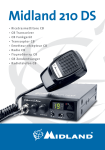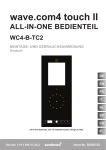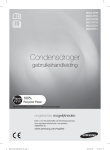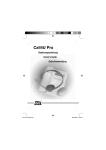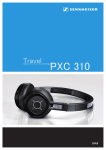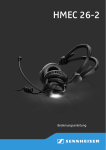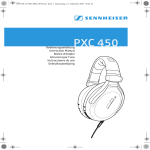Download Sennheiser HMEC 25-KA User's Manual
Transcript
HMEC 25-CA Gebrauchsanleitung Instructions for use Notice d‘emploi Istruzioni per l‘uso Instrucciones para el uso Gebruiksaanwijzing P/N 025-230-125 HMEC 25-KA P/N 025-230-115 ™ Lärm - wo begegnet er uns nicht? Ob am Arbeitsplatz, in der häuslichen Umgebung, in öffentlichen Verkehrsmitteln, auf Flug-, Bahn- oder Busreisen - eigentlich begleitet er uns überall. Die negativen Auswirkungen dieser Lärmbelästigungen sind durch Studien belegt und auch jeder von uns wird sie schon gespürt haben: 왘 왘 왘 Nervosität Konzentrationsmangel Gereiztheit ... sind nur die augenscheinlichen Auswirkungen auf den Organismus. Lärm wirkt zudem auf das vegetative Nervensystem und kann zu Dauerschäden des Gehörs führen. Die Quellen des Lärms sind vielfältig und nur zu oft für den einzelnen nicht abzustellen. Daher kann nur der persönliche Schutz an einem lärmerfüllten Ort eine Lösung darstellen. Mit dem System NoiseGard™ hat Sennheiser eine wirkungsvolle Lösung realisiert. Das Funktionsprinzip und die Bedienung wird Ihnen in dieser Anleitung erläutert. Schallpegel von Lärmquellen Laut Gebrauchsanleitung ............................................................................................... 3 Instructions for use .............................................................................................. 11 Notice d´emploi .................................................................................................... 19 Istruzioni per l´uso ............................................................................................... 27 Instrucciones para el uso ..................................................................................... 35 Gebruiksaanwijzing .............................................................................................. 43 2 Leise 140 dB 130 dB Düsentriebwerk (25m Entfernung) Flugzeugmotor 120 dB Druckluftbohrer 110 dB Schmiedehammer, Betonwerk 100 dB 90 dB Metalldruckgußmaschine Metallwerkstatt 80 dB Traktor 70 dB Büro 60 dB 50 dB Unterhaltung Umweltlärm 40 dB Wohnraum 30 dB Bibliothek 20 dB 10 dB Schlafzimmer Wald, windstill Die Maßeinheit für Schallpegel ist das Dezibel (dB). Eine Lärmdämpfung um 10 dB wird allgemein als Halbierung der Lautstärke empfunden, weitere 10 dB Dämpfung ergeben eine um 75% reduzierte Lärmempfindung u.s.w. 3 HMEC 25-CA / HMEC 25-KA Einlegen der Batterien im Speiseteil Eine Hör-/ Sprech-Garnitur faßt zwei Baugruppen, Kopfhörer und Mikrofon zu einer Funktionseinheit zusammen. Überwiegender Einsatzbereich dieser Hör-/ Sprech-Garnituren HMEC 25-KA/-CA ist die Kommunikation im Flugzeugcockpit. Die Kompensationselektronik NoiseGard™ wird durch eine Batteriebox im Kabel der Hör-/ Sprech-Garnitur mit Strom versorgt. Legen Sie zwei Batterien in die Batteriebox ein. 왘 왘 Als Mikrofon wird ein hochwertiges dauerpolarisiertes Elektretmikofon benutzt. Die notwendige Versorgungsspannung wird ( gemäß ARINC) über den Anschlußstecker aus dem Bordnetz des Flugzeuges bezogen. Als Kopfhörer dienen Sennheiser NoiseGard™-Systeme. Dies sind dynamische Hörersysteme, bei denen, zusätzlich zur Wiedergabe eines Audiosignales, auf elektronischem Weg tieffrequenter Störschall kompensiert wird. Die aktive Lärmkompensation funktioniert nach dem physikalischen Prinzip, daß sich Schall und "Antischall" (um 180° phasenverschoben) gegenseitig auslöschen. Die NoiseGard™-Kompensationselektronik im Kopfhörer benötigt eine gesonderte eigene Stromversorgung, die das fest mit dem Kabel verbundene Speiseteil (Siehe Abbildung rechts) liefert. Ungestörte Verständigung wird möglich, ohne die Lautstärke so laut einstellen zu müssen, daß die Umweltgeräusche übertönt werden. NoiseGard™ erhöht den Komfort, ist aber kein medizinischer Hörschutz ! EIN- / Ausschalten Der EIN/AUS-Schalter für die Stromversorgung der Kompensationselektronik befindet sich an der Vorderseite der Batteriebox. Kontroll-LED Die LED auf der Batteriebox informiert Sie über den Batteriezustand: 왘 Leuchtet die LED grün, wird die Kompensationselektronik ausreichend mit Strom versorgt. 왘 Leuchtet die LED rot, sind die Batterien fast erschöpft und müssen jetzt getauscht werden. Noch ist NoiseGard™ in Funktion. 왘 Bleibt die LED nach dem Einschalten dunkel, sind die Batterien vollkommen erschöpft, die Hör-/ Sprech-Garnitur bleibt weiter einsatzbereit, aber ohne Lärmkompensation. Das Mikrofon ist durch die eigene Spannungsversorgung aus dem Bordnetz des Flugzeuges unabhängig von den Batterien und bleibt immer in Funktion. Geräuschkompensation mit NoiseGard™ Noise compensation HMEC 25 Reduction/dB 0 EIN/AUS active 10 passive 20 LED 30 40 20 4 100 1000 10000 20000 Frequency/Hz 5 Kabel (rechts oder links) Mikrofonarm einstellen 350° Hinweis: Der Mikrofonarm kann durch Biegen individuell angepaßt werden. Diese Einstellung sollte möglichst nicht ständig geändert werden, bei sehr häufigem Hin- und Herbiegen kann der Arm brechen! Kopfbügel einstellen Kabel links HINWEISE Kabel rechts NoiseGard™ dient der Geräuschverminde- rung zur Erhöhung des Komforts. NoiseGard™ ist kein medizinisches Lärmschutzsystem! NoiseGard™ ersetzt kein industrielles Lärmschutzsystem zum Einsatz in lärmerfüllter Umgebung! Laut hören ? - NEIN ! Mit einem Kopfhörer wird gern lauter als mit Lautsprechern gehört. Hohe Lautstärke, die über längere Zeit auf Ihre Ohren einwirkt, kann zu dauerhaften Hörschäden führen. Schützen Sie Ihr gesundes Gehör, Sennheiser-Kopfhörer klingen auch bei niedriger Lautstärke besonders gut ... 6 7 Blockschaltbild HMEC 25 CA � boom microphone headphone capsule (left) microphone amplifier compensation circuit (left) compensation microphone (left) compensation microphone (right) headphone capsule (right) compensation circuit (right) battery box Klettband (selbstklebend) � 5-pin XLR plug Blockschaltbild HMEC 25 KA MZQ 2002-1 boom microphone headphone capsule (left) compensation microphone (left) compensation microphone (right) headphone capsule (right) Lieferumfang microphone amplifier compensation circuit (left) compensation circuit (right) battery box 3-pin plug 8 1 HMEC 25-KA oder HMEC 25-CA 1 Schutz- und Transporttasche 1 Windschirm MZW 45 (Art.Nr. 75823) 1 Klettband (selbstklebend), Abb. � 1 Klemmhalter MZQ 2002-1 (Art.Nr. 44740), Abb. � 3-pin plug 9 Technische Daten Wandlerprinzip Übertragungsbereich Impedanz aktiv/passive Klirrfaktor Lärmdämpfung aktiv Frequenzbereich der aktiven Lärmdämpfung NoiseGard™ HMEC 25-KA / -CA The Problem of Noise Kopfhörer The negative effects of noise pollution have been proven by studies, and everybody will have experienced them at some time or another: dynamisch, geschlossen, ohraufliegend 16 Hz - 22 kHz 200 Ohm (mono) 400 Ohm pro Seite (stereo) Lautstärke aktiv und passiv gleich <1% 15 dB + 3 dB im Bereich von 100 Hz - 2 kHz 50 - 600 Hz Mikrofon incl. Vorverstärker Wandlerprinzip Übertragungsbereich bei einem Abstand von 2 cm zum Mundwinkel max. Schalldruckpegel Ausgangsspannung Abschlußwiderstand Versorgungsspannung 왘 왘 왘 Nervousness Lack of concentration Irritability And these are only the most obvious effects on the human body. Noise also affects the autonomic nervous system and can lead to permanent hearing damage. There are a multitude of noise sources, and the individual very often has no influence over them. The only solution when being in a noisy place is protecting oneself against ambient noise. These noise problems are particularly prevalent in an aircraft cockpit where a pilot often has to have the communications headset so loud as to risk permanent hearing damage. Back-Elektret-Kondensatorkapsel, geräuschkompensiert With the NoiseGard™ system, Sennheiser has come up with an effective solution. These operating instructions explain the NoiseGard™ principle and show you how to use the NoiseGard™ headset. 300 Hz - 5 kHz entsprechend DO-214 120 dB (Klirrfaktor 1 %) 400 mV ± 3 dB bei 114 dB aus 6 mm Abstand (entsprechend DO-214) 150 Ohm 8 - 16 V DC, ca 8 - 25 mA, Beschaltung nach RTCA/DO 214 Noise levels loud Allgemeine Daten Kopfhörer-Andruckkraft Gewicht ohne Kabel Kabel Stecker HMEC25-KA: HMEC25-CA: Stromversorgung Betriebszeit Anzeige: 10 ca 2,5 N 170 g einseitig, Länge gesamt: 1,8 m Stereo-Klinke 6,3 mm, mono beschaltet PJ-068, 5,25 mm Mikrofon XLR-5 2 x 1,5 V Mignon (AA) Alkali-Mangan Batterien (2700 mAh) ca. 20 h Zweifarben-LED zur Batteriekontrolle quiet 140 dB Jet engine (at a distance of 25 m) 130 dB Aircraft engine (This is the treshold of pain) 120 dB 110 dB Pneumatic drill Blacksmith's hammer, concrete works 100 dB Die-cast machine 90 dB Metal workshop 80 dB 70 dB Tractor Office 60 dB Conversation 50 dB 40 dB Ambient noise Living room 30 dB Library 20 dB Bedroom 10 dB Forest, no wind The unit of sound levels is the decibel (dB). A noise reduction of 10 dB is generally perceived as a halving of the loudness, another 10 dB decrease halves the loudness yet again whitch corresponds to a loudness reduction of 75 %, and so on. 11 HMEC 25-KA / HMEC 25-CA Inserting the batteries into the battery box A headset is comprised of two units, a headphone and a microphone. The HMEC 25-KA/-CA headset is mostly used for communication in aircraft cockpits. The NoiseGard™ compensation circuitry is powered via a battery pack integrated into the headset cable. Insert two AA size batteries into the box as shown in the digram below. 왘 왘 The microphone is a high quality back-electret condenser microphone. As per ARINC it receives its operating voltage via a connector from the aircraft´s internal power supply. The headphone is a Sennheiser NoiseGard™ system. This is a dynamic headphone system which, in addition to reproducing the original audio signal, electronically cancels the low frequencies of the ambient noise. This active noise compensation operates on the principle that sound and ”anti-sound“ (in phase opposition) cancel each other out. The NoiseGard™ compensation circuitry in the headphone requires an extra power supply, so a battery compartment has been integrated into the headset cable (see illustration on the right). Switching the power supply on/off The on/off switch for the power supply of the compensation circuitry is at the front of the battery box. Pilot light An LED on the battery box indicates the battery status: Clearly intelligible communication is ensured, and the pilot no longer has to turn the volume up to overcome ambient noise. 왘 When the LED lights up green, the power supply for the compensation circuitry is sufficient. NoiseGard™ increases your comfort, 왘 When the LED is red, the batteries are almost flat and should be changed immediately. The NoiseGard™ system is still operational. 왘 If the LED does not light up at all when the power supply is switched on, the batteries are completely flat. The headset is still operational but without the noise compensation. but it is not a medical hearing protection! The microphone is powered by the aircraft‘s internal power supply. Thus, it is independent of the batteries and always remains operational. Active noise compensation with NoiseGard™ Noise compensation HMEC 25 Reduction/dB 0 ON/OFF active 10 passive 20 LED 30 40 20 12 100 1000 10000 20000 Frequency/Hz 13 Cable (worn on the right or left side) Adjusting the microphone boom 350° N.B.: The microphone boom is adjusted for an individual user. However, care should be taken when doing this. Once set, the boom should not be re-adjusted. If it is continually flexed it is liable to break. Adjusting the headband Cable on the left N.B.: Cable on the right NoiseGard™ reduces noise and increases comfort. NoiseGard™ is not a medical noise protection system! NoiseGard™ cannot replace an industrial ear defender system for use in noisy environments! Volume up? - NO ! When people use headphones, they tend to choose a higher volume than with loudspeakers. Listening with high volume levels for a longer time can lead to permanent hearing defects. Because the NoiseGard™ circuitry is reducing the ambient noise, the headphones can be set at a correspondingly lower level leading to more comfortable hearing conditions so protecting your hearing. 14 15 HMEC 25-CA Block Diagram � boom microphone headphone capsule (left) microphone amplifier compensation circuit (left) compensation microphone (left) compensation microphone (right) headphone capsule (right) compensation circuit (right) battery box self-adhesive piece of velcro � 5-pin XLR plug HMEC 25-KA Block Diagram MZQ 2002-1 boom microphone headphone capsule (left) compensation microphone (left) compensation microphone (right) headphone capsule (right) Supply schedule microphone amplifier compensation circuit (left) compensation circuit (right) 1 HMEC 25-KA or HMEC 25-CA 1 Carrying case 1 wind-shield MZW 45 (Art.No 75823) 1 self-adhesive piece of velcro, fig. � 1 MZQ 2002-1 clip (Art.No 44740), fig. � battery box 3-pin plug 16 3-pin plug 17 Technical data NoiseGard™ HMEC 25-KA / -CA Headphone Transducer principle Frequency response Impedance active/passive THD Compensation active and passive Frequency response of the active compensation dynamic, open, supra-aural 16 Hz - 22 kHz 200 Ω (mono) 400 Ω per side (stereo) same volume for active and passive <1% 15 dB + 3 dB in the range of 100 Hz - 2 kHz 50 - 600 Hz Microphone incl. preamplifier Transducer principle Frequency response (2 cm distance between mic and corner of mouth) Max. sound pressure level Output voltage Terminating impedance Operating voltage Noise-cancelling back-electret condenser microphone capsule 300 Hz - 5 kHz (as per DO-214) 120 dB (THD=1 %) 400 mV ± 3 dB at 114 dB and a distance of 6 mm (as per DO-214) 150 Ω 8 - 16 V DC, approx. 8-25 mA, connections as per RTCA/DO 214 General Data Contact pressure Weight without cable Cable Connectors HMEC 25-KA HMEC 25-CA Power supply Operating time Display 18 approx. 2.5 N 170 g single-sided, total length 1.8 m headphone: 3-pole 1/4" (6,35mm) jack plug wired mono microphone: PJ-068, 5.25 mm XLR-5 2 x 1.5 V AA sizealkaline-manganese batteries (2700 mAh) approx. 20 hrs two-colour LED for indicating battery status Le bruit - il est partout ! Que ce soit sur le lieu de travail, à la maison, dans les transport publics, en avion, en train ou en car - il y a toujours du bruit. De nombreuses études ont démontré les effets négatifs de cette pollution par le bruit - et tout le monde les connaît: 왘 왘 왘 nervosité manque de concentration irritabilité... - et ce sont seulement les effets les plus évidents. Le bruit attaque aussi le système neurovégétatif et peut entraîner une détérioration définitive de l´ouïe. Les sources du bruit sont multiples, et la plupart du temps on n´est pas maître de le faire cesser. La seule solution dans un environnement bruyant est donc de se protéger individuellement. C´est surtout vrai pour les pilotes. Dans les cockpits, le bruit est un très grand problème, et souvent, le pilote doit ajuster l´ensemble casque/micro si fort qu´il risque d´endommager son ouïe de façon permanente. Avec le système NoiseGard™, Sennheiser a créé une solution très efficace. Son principe de fonctionnement et son emploi sont décrits dans ce guide. Quelques niveaux sonores haut bas 140 dB 130 dB Moteur à réaction (à 25 m) Moteur d´avion 120 dB Perceuse pneumatique 110 dB Marteau de forge, usine de béton 100 dB 90 dB Machine à mouler sous pression Usinage des métaux 80 dB Tracteur 70 dB Bureau 60 dB 50 dB Conversation Bruit ambiant 40 dB Salle de séjour 30 dB Bibliothèque 20 dB 10 dB Chambre à coucher Forêt, calme L´unité de mesure du niveau sonore est le décibel (dB). Une atténuation sonore de 10 dB est en général perçue comme une réduction du bruit de 50 % ; si l´on atténue encore ce volume de 10 dB, la réduction sonore perçue du bruit est 75 %, et ainsi de suite. 19 HMEC 25-CA / HMEC 25-KA Comment insérer les batteries dans le boitier piles L´ensemble casque/micro HMEC 25-KA/-CA est avant tout conçu pour la communication dans les cockpits d´avion. L‘électronique de compensation NoiseGard™ est alimenté par un boîtier piles intégré dans le câble de l‘ensemble casque/micro. Y insérez deux piles comme montré cidessous. 왘 Comme microphone, on a choisi un microphone autopolarisé haut de gamme. La tension d´alimentation est prise - selon ARINC - sur le circuit de bord. 왘 Le casque emploie le système NoiseGard™. C´est un système dynamique qui, en plus de reproduire le signal audio, compense électroniquement les bruits basses fréquences. La compensation active du bruit fonctionne sur le principe selon lequel son et «antison» (déphasé de 180°) s´annulent réciproquement. Pour cette compensation NoiseGard™, l´électronique dans le casque nécessite une alimentation séparée qui est integrée dans le cable (voir illustration à droite). Comment allumer ou éteindre la compensation de bruit La communication devient parfaitement intelligible , et il ne faut plus pousser le volume pour couvrir le bruit ambiant. LED témoin Le commutateur marche/arrêt (ON/OFF) pour l‘alimentation de la compensation NoiseGard™ se trouve sur la partie frontale du boîtier piles. La LED témoin sur le boîtier piles indique le niveau des piles. 왘 Quand la LED est verte, l‘alimentation de l‘électronique de compensation est suffisante. 왘 Quand la LED est rouge, les piles sont presque épuisées. Il faut les changer immédiatement. Le système NoiseGard™ fonctionne toujours. 왘 Si la LED reste sombre quand vous allumez la compensation de bruit, les piles sont complètement épuisées. On peut toujours utiliser l‘ensemble casque/ micro, mais sans compensation de bruit, car le microphone est raccordé à l‘alimentation de bord et reste donc opérationnel. NoiseGard™ augmente le confort, mais ce n´est pas une protection médicale pour l´ouïe ! Compensation du bruit avec NoiseGard™ Noise compensation HMEC 25 Reduction/dB Commutateur ON/OFF 0 active 10 passive 20 LED 30 40 20 20 100 1000 10000 20000 Frequency/Hz 21 Câble (à gauche ou à droîte) Comment ajuster le bras du microphone 350° Important : Le bras du microphone est ajusté pour un utilisateur individuel. Si on l‘ ajuste plusieurs fois on risque de le briser ! Comment ajuster l´arceau du casque Câble à gauche N.B.: Câble à droite NoiseGard™ sert à réduire le bruit et à augmenter le confort. NoiseGard™ n´est pas une protection médicale pour l´ouïe! NoiseGard™ ne peut pas remplacer un système industriel de protection contre le bruit qu´il faut utiliser dans un environnement bruyant! Pousser le volume ? - NON ! Avec un casque, on préfère d´écouter plus fort qu´avec les haut-parleurs. Des volumes forts pendant un temps prolongé peuvent entraîner une détérioration définitive de l´ouïe. Comme l´électronique NoiseGard™ réduit le bruit ambiant, le casque peut être ajusté à un niveau plus bas. L´écoute devient plus confortable et votre ouïe sera protégée. 22 23 Schema fonctionel HMEC 25-CA � boom microphone headphone capsule (left) microphone amplifier compensation circuit (left) compensation microphone (left) compensation microphone (right) headphone capsule (right) compensation circuit (right) battery box la bande velcro (auto-collante) � 5-pin XLR plug Schema fonctionel HMEC 25-KA MZQ 2002-1 boom microphone headphone capsule (left) compensation microphone (left) compensation microphone (right) headphone capsule (right) Contenu microphone amplifier compensation circuit (left) compensation circuit (right) 1 HMEC 25-KA ou HMEC 25-CA 1 Sacoche 1 bonnette anti-vent (Art.No 75823) 1 la bande velcro (auto-collante), fig. � 1 fixation à pince MZQ 2002-1 (Art.No 44740), fig. � battery box 3-pin plug 24 3-pin plug 25 caractéristiques techniques Principe transducteur Bande passante Impédance active/passive Distorsion harmonique Compensation active et passive Bande passante du compensation NoiseGard™ HMEC 25-KA / -CA Rumore - Dove nonv lo incontriamo ? Casque Sia sul posto di lavoro che nell'ambiente domestico, nei mezzi di trasporto pubblici, nei viaggi in aereoplano, in ferrovia o in pullman - esso ci accompagna dovunque. dynamique, ouvert, supra-aural 16 Hz - 22 kHz 200 Ω (mono) 400 Ω par côté (stéréo) Volume active et passive egale <1% 15 dB + 3 dB de 100 Hz à 2 kHz 50 - 600 Hz Microphone, préamplificateur inclus Principe transducteur Bande passante (distance entre microphone et le bord de la bouche: 2 cm) Niveau de pression acoustique Tension de sortie Impédance de charge Tension d´alimentation Capsule à électret (autopolarisée) à compensation de bruit 300 Hz - 5 kHz, conforme à DO-214 max. 120 dB (distorsion 1 %) 400 mV ± 3 dB à 114 dB à 6 mm de distance (conforme à DO-214) 150 Ω 8 - 16 V DC, approx. 8-25 mA, connexions selon RTCA/DO 214 Caractéristiques générales Pression exercée par les écouteurs Poids sans câble câble Connecteurs HMEC 25-KA HMEC 25-CA Alimentation Autonomie Témoin 26 approx. 2,5 N 170 g eunilatéral, longueur totale 1,8 m connecteur stéreo 6,3 mm (casque) câblage mono PJ-068, 5,25 mm (microphone) XLR-5 2 piles alcali-manganèse, 1,5 V type LR 6 (2700 mAh) piles: approx. 20 h LED bi-couleur comme contrôle piles Gli effetti negativi di questi rumori fastidiosi sono comprovati da studi effettuati e anche ciascuno di noi li avrà già provati. 왘 nervosismo 왘 mancanza di concentrazione 왘 irritabilità... sono solo gli effetti più appariscenti sull'organismo. Il rumore agisce inoltre sul sistema neurovegetativo e può provocare danni permanenti all'udito. Le fonti di rumore sono molteplici e troppo spesso non eliminabili per il singolo individuo. Per questo motivo solo la protezione personale in un luogo rumoroso può rappresentare una soluzione. Con il sistema NoiseGard™ la Sennheiser ha realizzato una soluzione efficace. Il principio di funzionamento e l'impiego Vi vengono spiegati in queste istruzioni. Livello di pressione acustica delle sorgenti sonore Rumoroso Silenzioso 140 dB 130 dB Motore a reazione (distanza 25 m) Motore di aeroplane 120 dB Martello pneumatico 110 dB Martello fucinatura, betoniera 100 dB 90 dB Macchina per pressofusione di metalli Officina metalmeccacica 80 dB Trattore 70 dB Ufficio 60 dB 50 dB Conversazione Rumore ambientale 40 dB Soggiorno 30 dB Biblioteca 20 dB 10 dB Camera da letto Bosco, senza vento L'unità di misura per il livello di pressione acustica è il decibel (dB). Un'attenuazione del rumore di 10 dB viene generalmente percepita come un dimezzamento del volume, un'attenuazione di altri 10 dB fornisce una percezione sonora ridotta del 75% ecc. 27 HMEC 25-CA / HMEC 25-KA Inserimento delle pile nell'alimentatore Una cuffia riunisce due gruppi costruttivi, l'auricolare e il microfono, in una unità funzionale. Il prevalente campo di impiego di queste cuffie HMEC 25-KA/CA è la comunicazione nella cabina dei piloti di aereoplani. L’elettronica di compensazione NoiseGard™ viene alimentata con corrente da un box pile nel cavo della cuffia. Inserire due pile nel box. 왘 왘 Come microfono viene utilizzato un microfono a elettrete a polarizzazione continua di alta qualità. La tensione di alimentazione necessaria viene fornita (in conformità a ARINC) dalla rete di bordo del velivolo attraverso la spina di collegamento. Come cuffia vengono impiegati i sistemi Sennheiser NoiseGard™ . Questi sono sistemi di cuffie dinamici, nei quali, oltre alla riproduzione di un segnale audio, il rumore a bassa frequenza viene compensato per via elettronica. La compensazione attiva del rumore funziona in base al principio fisico che il rumore e l'"antirumore" (con uno spostamento di fase di 180˚) si cancellano a vicenda. L'elettronica di compensazione NoiseGard™ nella cuffia necessita di un'alimentazione elettrica propria, che viene fornita dall'alimentatore (vedi figura a destra) collegata con comando fisso al cavo. La comprensione senza disturbo diventa possibile senza dover regolare il volume al punto da coprire i rumori dell'ambiente. NoiseGard™ aumenta il confort, non è tuttavia una protezione medica dell'udito! Inserimento/disinserimento L’interruttore di INSERIMENTO/DISINSERIMENTO per l’alimentazione elettrica dell’elettronica di compensazione si trova sul lato anteriore del box delle pile. LED di controllo Il LED sul box delle pile informa sullo stato delle pile: 왘 Se il LED si accende di luce verde, l’elettronica di compensazione viene alimentata con corrente sufficiente. 왘 Se il LED si accende di luce rossa, le pile sono quasi scariche e devono essere sostituite. NoiseGard™ è ancora in funzione. 왘 Se il LED rimane spento dopo l’inserimento, le pile sono completamente scariche, la cuffia rimane pronta al funzionamento, ma senza compensazione del rumore. Il microfono è indipendente dalle pile grazie alla propria alimentazione della tensione dalla rete di bordo dell’aeroplano e rimane sempre in funzione. Compensazione del rumore comn NoiseGard™ Noise compensation HMEC 25 Reduction/dB 0 INSERIMENTO / DISINSERIMENTO active 10 passive 20 LED 30 40 20 28 100 1000 10000 20000 Frequency/Hz 29 Cavo (a aestra o a sinistra) Regolazione del braccio del microfono 350° Il braccio del microfono può essere regolato individualmente piegandolo. Si raccomanda tuttavia di evitare di regolarlo troppo spesso in quanto potrebbe eventualmente rompersi. Regolazione della staffa per la testa Cavo a sinistra AVVERTENZE Cavo a destra NoiseGard™ serve a ridurre il rumore per aumentare il confort. NoiseGard™ non è un sistema medico di protezione contro il rumore! NoiseGard™ non sostituisce nessun sistema di protezione industriale contro il rumore, da impiegare in un ambiente rumoroso! Ascoltare ad alto volume? - NO! Con una cuffia si ascolta volentieri ad un volume più alto che non con gli autoparlanti. Un volume alto, che agisce sulle Vostre orecchie per un tempo prolungato, può provocare danni permanenti all'udito. Proteggete il Vostro udito sano, le cuffie Sennheiser hanno un bel suono anche a basso volume... 30 31 Schema a blocchi HMEC 25 CA � boom microphone headphone capsule (left) microphone amplifier compensation circuit (left) compensation microphone (left) compensation microphone (right) headphone capsule (right) compensation circuit (right) battery box il nastro velcro (autoadesivo) � 5-pin XLR plug Schema a blocchi HMEC 25 KA MZQ 2002-1 boom microphone headphone capsule (left) compensation microphone (left) compensation microphone (right) headphone capsule (right) Volume fornitura: microphone amplifier compensation circuit (left) compensation circuit (right) 1 HMET 25-KA oppure HMEC 25-CA 1 tasca di protezione e di trasporto 1 cuffia antivento MZW 45 (Art.No. 75823) 1 il nastro velcro (autoadesivo), fig. � 1 supporto di fissaggio MZQ 2002-1(Art.No 44740), fig. � battery box 3-pin plug 32 3-pin plug 33 Dati tecnici Principio convertitore Banda di trasmissione Impedenz attiva/passiva: Fattore di distorsione Smorzamento rumore Risposta armonica dello smorzamento rumore attivo NoiseGard™ HMEC 25-KA/-CA El ruido - ¿Dónde podemos aislarnos de él? Cuffia Bien sea en el puesto de trabajo, en la vivienda, en los medios de transporte público, en los viajes en avión, en tren o en bus: en todas partes hay ruido. dinamico, chiuso, sopraurale 16 Hz - 22 kHz 200 ohm (mono) 400 ohm per ogni lato (stereo) Volume attivo e passivo uguale <1% 15 dB + 3 dB nel campo di 100 Hz - 2 kHz 왘 50 - 600 Hz son tan sólo los efectos aparentes causados en el organismo. El ruido, sin embargo, influye además en el sistema nervioso vegetativo y puede ocasionar daños permanentes de la capacidad auditiva. Microfono incl. preamplificatore Principio convertitore Banda di trasmissione ad una distanza di 2 cm dall’angolo della bocca Max livello pressione sonora Tensione di uscita Resistenza terminale Tensione di alimentazione HMEC25-CA Alimentazione elettrica Durata esercizio Indicazione: 34 왘 왘 La nerviosidad, la falta de concentración, y la irritabilidad ..., Capsula condensatore controelettrodo elettrite, con compensazione del rumore Los orígenes del ruido son múltiples y, con frecuencia, imposibles de suprimir. Por eso, en un lugar ruidoso, únicamente la protección personal constituye una solución adecuada. 300 Hz - 5 kHz in conformità a DO-214 Con el sistema NoiseGard™ Sennheiser ha logrado una solución efectiva. Su funcionamiento y manejo se explican en estas instrucciones. 120 dB (fattore distorsione 1 %) 400 mV ± 3 dB a 114 dB distanza 6 mm (in conformità a DO-214) 150 ohm 8 - 16 VDC, ca 8 - 25 mA, cablaggio secondo RTCA/DO-214 Dati generali Forza pressione cuffia Peso senza cavo Cavo Spina HMEC25-KA Los efectos negativos de las molestias que causa el ruido han sido documentados por medio de estudios. Y, también, cada uno de nosotros los habrá sentido. ca. 2,5 N 170 g su un lato, lunghezza totale: 1,8 m Connettore jack stereo, 6,3 mm cuffia collegato solo mono PJ-068, 5,25 mm microfono XLR-5 pile ad alcali-manganese mignon 2 x 1,5 V (AA) (2700 mAh) ca. 20 H LED a due colori per controllo pila Nivel de sonoridad de las fuentes de ruidos 140 dB Alto Bajo Mecanismo de accionamiento a reacción (25 m de distancia) 130 dB Motor de avión 120 dB Taladro neumático 110 dB Martello de forja, fábrica de hormigón 100 dB Máquina de fundición a presión (de metales) 90 dB Taller metalúrgico 80 dB Tractor 70 dB Oficina 60 dB Recreación 50 dB Ruido medioambiental 40 dB Vivienda 30 dB Biblioteca 20 dB Dormitorio 10 dB Bosque, sin viento El decibelio (dB) es la unidad de medida para expresar la intensidad de los sonidos. En general, una atenuación de ruidos de 10 dB se percibe como una disminución de un 50% de la intensidad del sonido; una amortiguación adicional de 10 dB disminuye la percepción de ruidos en un 75%, etc. 35 HMEC 25-CA / HME 25-KA Colocación de las pilas en el bloque de alimentación El juego de intercomunicación reúne dos módulos, es decir el auricular y el micrófono, es una sóla unidad funcional. Estos juegos de intercomunicación HMEC 25-KA/-CA se emplean sobre todo para efectos de comunicación en cabinas de aviones. La alimentación de corriente para la electrónica de compensación NoiseGard™ se efectúa por medio de una caja de pilas en el cable del juego de intercomunicación. Coloque dos pilas en el la caja. 왘 Conexión y desconexión 왘 왘 Como micrófono se emplea un micrófono electreto de alta calidad, polarizado permanentemente. La tensión de abastecimiento necesaria (según ARINC) se toma de la red de a bordo del avión, a través del enchufe de conexión. Como auriculares se emplean los sistemas NoiseGard™ de Sennheiser. Estos son sistemas de auriculares dinámicos en los cuales, además de la reproducción de una señal de video, se compensa por medios electrónicos el sonido perturbador de baja frecuencia. La compensación de ruido activa funciona según el principio físico según el cual, la sonoridad y la "antisonoridad" se anulan recíprocamente (mediante la oposición de fase en 180˚). La eléctronica de compensación NoiseGard™ existente en el auricular requiere su propia alimentación de corriente, que es proporcionada por el bloque de alimentación, unido firmemente al cable del auricular (ver la ilustración a la derecha). De tal forma se logra una comunicación sin perturbaciones, sin tener que regular el sonido a un volumen tan alto como para poder suprimir los ruidos medioambientales. NoiseGard™ aumenta el confort aunque no es un sistema médico de protección auditiva El interruptor de CONEXIÓN/DESCONEXIÓN de la alimentación de corriente de la electrónica de compensación se encuentra en la cara frontal de la caja de pilas. LED de control El LED que hay en la caja le indica a Vd. el estado de las pilas: 왘 Si el LED se ilumina en verde, indica que la alimentación de corriente para la electrónica de compensación es suficiente. 왘 Si el LED se ilumina en rojo, las pilas están casi descargadas y es necesario sustituirlas. El NoiseGard™ funciona todavía. 왘 Si después de conectar el aparato el LED permanece oscuro, es indicación de que las pilas están totalmente descargadas; el juego de intercomunicación funciona, pero sin compensación de ruidos. El micrófono toma la tensión de abastecimiento necesaria de la red de a bordo del avión, no depende de las pilas y permanece siempre en funcionamiento. Compensación de ruidos con NoiseGard™ Noise compensation HMEC 25 Reduction/dB 0 CON./DESCON active 10 passive 20 LED 30 40 20 36 100 1000 10000 20000 Frequency/Hz 37 Cable (a la derecha/a la izquierda) Ajuste del brazo del microfono 350° El brazo del micrófono puede doblarse para adaptarlo según el gusto individual. Sin embargo no es aconsejable cambiar este ajuste permanentemente; al doblar el brazo a menudo hacia un lado y otro podría romperse. Ajuste de los aros del auricular Cable a la izquierda OBSERVACIONES Cable a la derecha NoiseGard™ sirve para disminuir los ruidos, a la vez que se aumenta el confort. NoiseGard™ no es un sistema médico para protección contra los ruidos. NoiseGard™ no es un sistema industrial de protección contra ruidos para uso en ambientes muy ruidosos. ¿Oir a alto volumen ? - ¡NO! Generalmente, quien usa un auricular se inclina a aumentar el volumen por encima del que se obtiene en los altavoces. Sin embargo, el efecto del nivel de sonido a todo volumen y durante largo tiempo puede ocasionar daños permanentes de la audición. Proteja su oído el sonido de los auriculares Sennheiser es siempre sobresaliente, incluso a bajo volumen ... 38 39 Diagrama de bloques HMEC 25 CA � boom microphone headphone capsule (left) microphone amplifier compensation circuit (left) compensation microphone (left) compensation microphone (right) headphone capsule (right) compensation circuit (right) battery box la cinta autoadhesiva � 5-pin XLR plug Diagrama de bloques HMEC 25 KA MZQ 2002-1 boom microphone headphone capsule (left) microphone amplifier compensation microphone (left) compensation circuit (left) compensation microphone (right) headphone capsule (right) compensation circuit (right) Volumen del suministro: 1 HMEC 25-KA ó HMEC 25-CA 1 bolsa protectora 1 caperuza antivento MZW 45 (Art.No. 75823) 1 la cinta autoadhesiva, fig. � 1 clip MZQ 2002-1 (Art. No. 44740), fig. � battery box 3-pin plug 40 3-pin plug 41 Datos tecnicos Principio transductor Gama de transmisión Impedancia activa/passiva: Factor de distorsión Atenuación de ruidos Respuesta de frecuencia de la atenuación activa de ruidos NoiseGard™ HMEC 25-KA/-CA Lawaai - waar vinden wij het niet? Auricular Op het werk, in de huiselijke omgeving, in openbare vervoermiddelen, bij vlieg-, trein- of busreizen - bijna overal worden wij door lawaai begeleid. dinámico, cerrado, suprauricular 16 Hz - 22 kHz 200 ohmios (mono), 400 ohmios/lado (estéreo) Volumen igual, activo o pasivo < 1% 15 dB + 3 dB en la gama de 100 Hz - 2 kHz 50 - 600 Hz Micrófono incl. preamplificador Principio transductor Gama de transmisión a distancia de 2 cm al ángulo de la boca Máx. presión sonora Tensión de salida Resistencia final Tensión de alimentación Cápsula de condensador retroelectreto, con compensación de ruidos 300 Hz - 5 kHz según DO-214 120 dB (factor de distorsión 1%) 400 mV ± 3 dB a 114 dB, a distancia de 6 mm (según DO-214) 150 ohmios 8 - 16 V DC, aprox. 8 - 25 mA, clase de circuito según RTCA/DO-214 Datos generales Fuerza de apriete del auricular Peso sin el cable Cable Enchufe HMEC25-KA HMEC25-CA Alimentación de corriente Tiempo de servicio Indicación 42 aprox. 2,5 N 170 g de un lado, largo total: 1,8 m jack estéreo 6,3 mm con conexión mono, auricular PJ-068, 5,25 mm, micrófono XLR-5 2 pilas Mignon de 1,5 V (AA), álcali-manganeso (2700 mAh) aprox. 20 h LED bicolor para control de la pila De negatieve invloed van deze geluidsoverlast is door studies bewezen en wij zullen het zelf ook allemaal wel al gemerkt hebben: 왘 왘 왘 Nervositeit gebrek aan concentratie geprikkelde stemming zijn slechts de duidelijk zichtbare uitwerkingen op het organisme. Lawaai heeft bovendien een negatieve werking op het vegetatieve zenuwstelsel en kan blijvende schade van het gehoor tot gevolg hebben. De bronnen van het lawaai zijn veelvoudig en vaak door het individu niet te onderscheiden. Daarom kan alleen de persoonlijke bescherming een oplossing bieden op plaatsen met geluidsoverlast. In het systeem NoiseGard™ heeft Sennheiser een werkzame oplossing gerealiseerd. Het principe van de functie en de bediening willen wij u in deze gebruiksaanwijzing toelichten. Geluidsniveau van lawaaibronnen Luid zacht 140 dB 130 dB Straalaandrijving (25 m afstand) Vliegtuigmotor 120 dB Persluchtboormachine 110 dB Smidhamer, betonfabriek 100 dB 90 dB Metaaldrukgietmachine Metaalwerkplaats 80 dB Tractor 70 dB Kantoor 60 dB 50 dB Gesprek Omgevingslawaai 40 dB Woonruimte 30 dB Bibliotheek 20 dB 10 dB Slaapkamer Bos, windstil De maateenheid voor het geluidsniveau is de Decibel (dB). Een demping van het lawaai met 10 dB wordt als halvering van de geluidsterkte waargenomen, nog eens 10 dB vermindering betekent een subjectief waargenomen reductie van 75% van het lawaai enz. 43 HMEC 25-CA / HMEC 25-KA Een luister-/spreekgarnituur vat twee bouwgroepen, hoofdtelefoon en microfoon tot een functie-eenheid samen. Het belangrijkste toepassingsgebied van deze luister-/ spreek-garnituren HMEC 25-KA/-CA is de communicatie in de cockpit van een vliegtuig. 왘 Als microfoon wordt een hoogwaardige continu gepolariseerde elektretmicrofoon toegepast. De noodzakelijke voeding wordt (overeenkomstig ARINC) via de aansluitstekker uit het boordnet van het vliegtuig opgenomen. 왘 Als hoofdtelefoon dienen Sennheiser NoiseGard™ systemen. Dit zijn dynamische luistersystemen waarbij naast de weergave van een audiosignaal op elektronische wijze storend lawaai met een diepe frequente wordt gecompenseerd. Deze actieve lawaaicompensatie functioneert volgens het natuurkundige principe dat geluid en antigeluid (180˚ in fase verschoven) zich tegen elkaar opheffen. De NoiseGard™ compensatie elektronika in de hoofdtelefoon heeft een eigen stroomverzorging nodig. Deze wordt geleverd door het netvoedingsgedeelte dat vast verbonden is met de kabel van de hoofdtelefoon (zie afbeelding rechts). Het wordt mogelijk om ongestoord van muziek te genieten zonder het volume zo luid te moeten instellen dat de geluiden van het milieu overspeeld worden. Batterijen in het voedingsgedeelte plaatsen De compensatie-elektronica NoiseGard™ wordt door een batterijvak in de kabel van de luister-/spreekset van stroom voorzien. Plaats twee batterijen in het batterijvak. In-/uitschakelen De AAN-/UIT-schakelaar voor de voedingsspanning van de compensatieelektronica zit op de voorzijde van het batterijvak. Controle LED De LED op het batterijvak geeft informatie over de toestand van de batterijen: 왘 Wanneer de LED groen oplicht, wordt de compensatie-elektronica van voldoende stroom voorzien. 왘 Wanneer de LED rood oplicht, zijn de batterijen bijna leeg en moeten onmiddellijk worden vervangen. De NoiseGard™ werkt nog steeds. 왘 Wanneer de LED na het inschakelen niet oplicht, zijn de batterijen helemaal leeg, de luister-/spreekset functioneert nog wel, echter zonder lawaaionderdrukking. 왘 Door de eigen voedingsspanning uit het boordnet van het vliegtuig is de microfoon niet afhankelijk van de batterijen en blijft altijd functioneren. NoiseGard™ verhoogt het comfort is echter geen medische gehoorbescherming! Geluidscompensatie met NoiseGard™ Noise compensation HMEC 25 Reduction/dB 0 aan/uit active 10 passive 20 LED 30 40 20 44 100 1000 10000 20000 Frequency/Hz 45 Kabel (rechts of links) Microfoonarm instellen 350° Opmerking: De arm van de microfoon kan door buigen individueel worden aangepast. Deze instelling moet echter zo weinig mogelijk worden gebruikt, want door vaak heen en weer buigen kan de arm breken! Hoofdbeugel instellen Kabel links OPMERKINGEN Kabel rechts NoiseGard™ dient ter reductie van het lawaai om zodoende het comfort te verhogen. NoiseGard™ is geen medisch lawaaibeschermingssysteem! NoiseGard™ vervangt geen industrieel lawaaibeschermingssysteem voor de toepassing in een omgeving met geluidsoverlast Luid luisteren ? - NEEN ! Met een hoofdtelefoon wordt vaak luider geluisterd als via luidsprekers. Een hoog volume dat gedurende een lage tijd op uw oren inwerkt kan tot permanente beschdigigen van het gehoor voeren. Bescherm uw gezonde gehoor, Sennheiserhoofdtelefoons klinken ook bij een laag volume bijzonder goed ... 46 47 Blokschakelschema HMEC 25 CA � boom microphone headphone capsule (left) microphone amplifier compensation circuit (left) compensation microphone (left) compensation microphone (right) headphone capsule (right) compensation circuit (right) battery box klitteband (zelfklevend) � 5-pin XLR plug Blokschakelschema HMEC 25 KA MZQ 2002-1 boom microphone headphone capsule (left) compensation microphone (left) compensation microphone (right) headphone capsule (right) Leveringspakket: microphone amplifier compensation circuit (left) compensation circuit (right) 1 HMEC 25-KA of HMEC 25-CA 1 beschermings- en transporttasje 1 windbeschermingskorfie MZW 45 (Art.No. 75823) 1 klitteband (zelfklevend), afb. � 1 klemhouder MZQ 2002-1(Art. No. 44740), afb. � battery box 3-pin plug 48 3-pin plug 49 Technische specificatie NoiseGard™ HMEC 25-KA / -CA Koptelefoon Omvormingsprincipe Overdrachtsbereik Impedantie actief/passief: Vervormingsfactor Geluiddemping actief en passief Frequentiekarakteristiek van de actieve geluiddemping Omvormingsprincipe Overdrachtsbereik bij een afstand van 2 cm t.o.v. de mondhoek Max. geluidsdrukpiek Uitgangsspanning Aansluitweerstand Voedingsspanning dynamisch, gesloten, op het oor liggend 16 Hz - 22 kHz 200 ohm (mono) 400 ohm per uitgang (stereo) Volume actief en passief gelijk < 1% 15 dB + 3 dB in het bereik van 100 Hz - 2 kHz HMEC25-CA Voedingsspanning Bedrijfstijd Weergave: Sennheiser electronic GmbH & Co. KG erklären, dass dieses Gerät die anwendbaren CE-Normen und Vorschriften erfüllt. Approval 50 - 600 Hz Microfoon incl. voorversterker Sennheiser electronic GmbH & Co. KG declare that this device is in compliance with the applicable CE standards and regulations. Back-Elektret-condensatorkapsel ruis onderdrukkend Certification 300 Hz - 5 kHz conform DO-214 120 dB (vervormingsfactor 1%) 400 mV ± 3 dB bij 114 dB vanuit 6 mm afstand (conform DO-214) 150 ohm 8 - 16 V DC, ca. 8 - 25 mA, geschakeld conform RTCA/DO-214 Algemene specificaties Drukkracht koptelefoon Gewicht zonder kabel Kabel Stekker HMEC25-KA Konformitätserklärung ca. 2,5 N 170 g enkelzijdig, totale lengte: 1,8 m stereo jack 6,3 mm (mono geschakeld) hoofdtelefoon PJ-068, 5,25 mm microfoon XLR-5 2 x 1,5 V Mignon (AA) Alkali-mangaan batterijen (2700 mAh) ca. 20 h twee kleuren LED voor controle van de batterijen Sennheiser electronic GmbH & Co. déclarons que cet appareil est en conformité avec les normes CE. Certificazione Sennheiser electronic GmbH & Co. KG dichiara che questo apparecchio risponde alle normative e alle prescrizioni CE applicabili. Autorizacion Sennheiser electronic GmbH & Co. KG declara que este aparato cumple las normas y directrices de la CE aplicables. Vergunning Sennheiser electronic GmbH & Co. KG verklaren, dat dit toestel voldoet aan de toepasselijke CE-normen en voorschriften. Aktuelle Informationen zu Sennheiser-Produkten erhalten Sie auch im Internet unter „http://www.sennheiser.com“. Up to date information on Sennheiser products can also be found on the Internet at “http://www.sennheiser.com”. Vous trouverez également toutes les informations actuelles relatives aux produits Sennheiser sur Internet, sous “http://www.sennheiser.com“. Informazioni attuali sulla gamma di prodotti Sennheiser sono disponibili anche in Internet al sito „http://www.sennheiser.com“. También en Internet, bajo „http://www.sennheiser.com“ obtendrá Vd. informaciones actuales sobre los productos Sennheiser. Actuele informatie met betrekking tot Sennheiser producten vindt u ook op Internet onder “http://www.sennheiser.com“. Änderungen vorbehalten Subject to alterations Modificaciones reservadas Sous réserve de modification Con riserva di modifiche Wijzigingen voorbehouden Sennheiser electronic GmbH & Co. KG D-30900 Wedemark Printed in Germany Telefon: 05130/600-0 Telefax: 05130/600-300 Publ. 01/03 58800 / A04
This document in other languages
- français: Sennheiser HMEC 25-KA
- español: Sennheiser HMEC 25-KA
- Deutsch: Sennheiser HMEC 25-KA
- Nederlands: Sennheiser HMEC 25-KA
- italiano: Sennheiser HMEC 25-KA



























